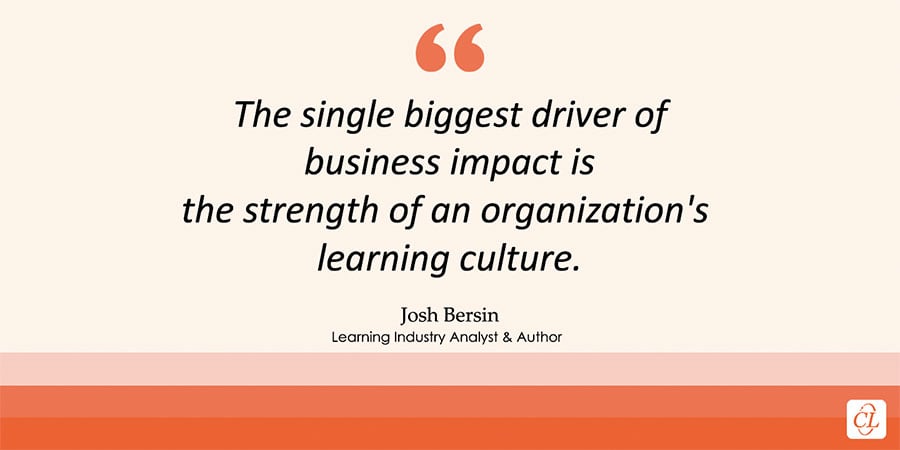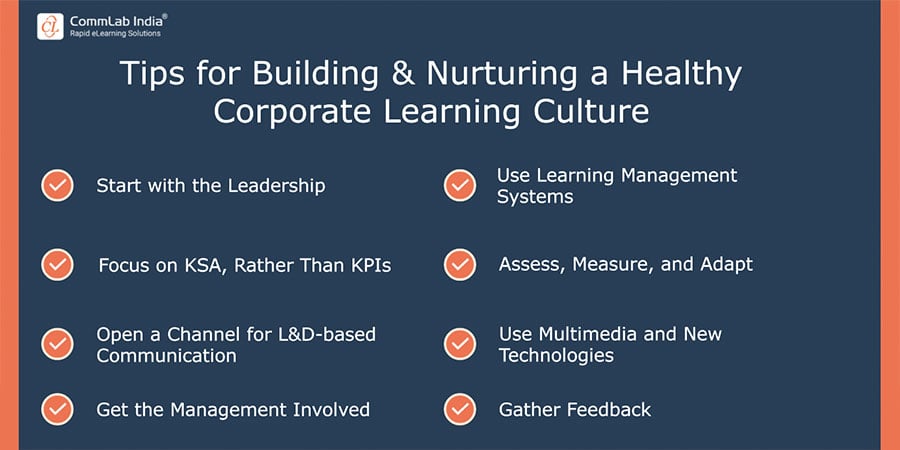8 Tips for Building a Healthy Learning Culture in Your Organization

The business landscape keeps changing every day, creating a need for creative new solutions for employee development. Building a healthy and self-sustaining learning culture is a task of utmost significance for L&D managers and specialists in every organization. A strong corporate culture that supports learning and development paves the way for consistent improvements in employee skills, thereby empowering them. This results in organizational growth, as well as an increase in employee satisfaction. In this article, we will take a closer look at some of the key strategies one can use to build, promote, and nurture a healthy corporate learning culture.
Building a Stable Learning Culture is an Essential Part of Every Organization’s Growth Plan
However, What Exactly Does a Healthy One Offer?
- Employee Empowerment
- Increased Innovation
- Performance Enhancement
- Talent Retention
Significance of Nurturing a Healthy Corporate Learning Culture
A healthy learning culture, by definition, creates an environment that supports learning initiatives, encouraging employees to gain new knowledge, develop essential skills to upgrade their performance, and offer them a chance to constantly grow. By doing so, an organization can ensure that the employees feel prepared for their tasks, engaged in their work, enjoy greater job satisfaction, and thereby elevates the overall well-being of the organization.

How Does a Healthy Learning Culture Benefit the Employees
- Empowers Employees: A healthy culture of learning allows the employees to take charge of their own development, according to their own plans for career growth. Ideally, it encourages employees to explore new areas, acquire new skills, and seek more opportunities to grow. A supportive learning environment offered by an organization enables the employees to reach their full potential, which not only empowers them but ultimately contributes to the success of the organization.
- Drives Innovation: For any organization, innovation is the most important thing required for achieving success and facilitating growth. Emphasis on learning always aids in boosting the employees’ potential for innovation as it encourages them to think freely yet critically, facilitates sharing of ideas and knowledge, and offers them the option to explore new avenues for problem-solving.
- Enhances Performance: Employees that gain access to learning opportunities and relevant upskilling resources through their organizations display brilliant potential for performance enhancement. Organizations, by implementing a healthy culture for L&D, enable employees to keep updating their knowledge banks so they are best equipped to deal with problems associated with their roles.
- Attracts and Retains Talent: Employee retention has become one of the key tasks in today’s volatile job market, as employees tend to seek out organizations that will offer them substantial opportunities for learning and development. A healthy culture that supports continuous learning can definitely help organizations in attracting sought-after talent and retain their highest-performing employees.
8 Tips for Building & Nurturing a Healthy Corporate Learning Culture

1. Start with the Leadership
Organizational leaders must be committed to and actively involved in fostering a learning culture. Leaders should priorities their own development, take an active role in learning programs, and stress the value of learning to the entire organization. Leaders set the tone for the organization when they show dedication to learning. Leaders foster an environment where continual learning and progress are valued by serving as outwardly visible champions of learning and encouraging staff to give their personal development top priority.
2. Focus on KSA, Rather Than KPIs
Change the emphasis from valuing the development of knowledge, skills, and abilities (KSA) to exclusively monitoring performance through Key Performance Indicators (KPIs). Encourage staff members to establish personal learning objectives that complement their professional aspirations. Give them access to training programs, mentoring opportunities, and platforms for ongoing learning to assist them attain their goals. Organizations can promote a culture that values learning as a means of both personal and professional development by placing a strong emphasis on the development of KSA.
3. Open a Channel for L&D-based Communication
Establish a platform or channel specifically for learning and development so that staff members can access resources, discuss their experiences, ask questions, and offer comments. This platform acts as a focal point for learning-related material and encourages teamwork and a sense of belonging among workers. It facilitates the sharing of ideas and best practices, encouraging ongoing learning and development. Organizations foster a culture of knowledge sharing and mutual learning by creating a space for conversation.
4. Get the Management Involved
Senior and intermediate managers should be involved in fostering a culture of learning among their teams. Encourage management to support and promote learning initiatives, offer chances for cross-functional teamwork, and reward staff who actively engage in learning opportunities. When managers put learning and development first, it reaffirms to workers the value of lifelong learning. Organizations can also guarantee that learning is incorporated into daily operations and is in line with their broader organizational plan by incorporating management in the process.
→ Download eBook: How L&D and Business can Align to Conquer Future of the Work
5. Use Learning Management Systems (LMS)
Utilize an effective Learning Management System (LMS) to manage training materials, streamline learning procedures, and monitor employee progress. An LMS delivers personalized learning paths, makes it simple to create and deliver online courses, and enables data to evaluate the success of learning initiatives. Employing an LMS enables businesses to make sure that learning opportunities are readily available, personalized, and measurable, empowering staff to study at their own speed and monitor their own development.
6. Assess, Measure, and Adapt or Redesign
Evaluate and measure the impact of learning efforts on a regular basis. Gather information on performance enhancement, skill development, and employee satisfaction. To learn about the needs and preferences of your stakeholders, ask your staff for input. Utilize this knowledge to modify and create learning programs to keep them current, interesting, and in line with organizational objectives. Organizations develop a culture that emphasizes continuous development and responds to the changing demands of the workforce by regularly reviewing and upgrading learning programs.
7. Use Multimedia and New Technologies
Use multimedia and cutting-edge technologies to design dynamic, fun learning experiences. To make learning more engaging and successful, incorporate films, interactive simulations, gamification components, and virtual reality. These tools support various learning styles and enhance information transmission and memory. Organizations can improve learning initiatives and foster a culture that welcomes novel learning strategies by integrating multimedia-enabled methods, such as video-based learning. Wondering how video-based learning can aid your corporate training processes? Watch this short video to know more.
8. Gather Feedback
Ask your staff for feedback on their learning experiences on a regular basis. To learn about their difficulties, preferences, and suggestions for improvement, conduct surveys, focus groups, or one-on-one interviews. This feedback offers insightful suggestions for boosting the overall learning process, improving learning initiatives, and filling in any gaps. Organizations may show their dedication to ongoing development and foster a culture that values employee participation and input by actively collecting feedback from their employees.
In the End
Creating a strong corporate learning culture has several advantages for businesses. Organizations can create an environment that promotes continuous learning, stimulates innovation, and enables staff members to realize their full potential by adhering to the eight suggestions covered in this article, which include starting with leadership, focusing on KSA, opening communication channels, involving management, using LMSs, assessing and adapting, utilizing multimedia and new age technologies, and gathering feedback.
Adopting a learning culture is a long-term commitment to development and success, not just a short-term endeavor. Download our eBook to know more about how business leaders and L&D professionals can come together to collectively achieve success.




![7 Ways Video-Based Learning is Transforming the Healthcare Industry [Infographic]](https://blog.commlabindia.com/hubfs/blogs/ways-video-based-learning-transforming-healthcare-industry-info.jpg)
